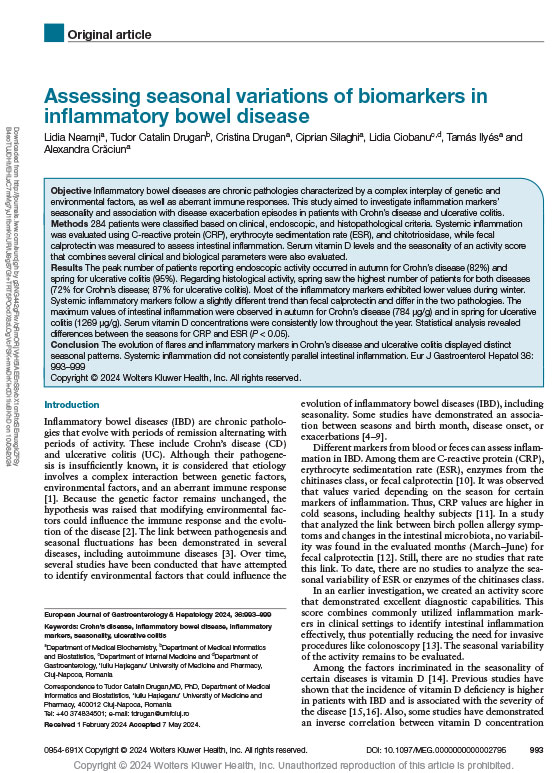Assessing seasonal variations of biomarkers in inflammatory bowel disease
August 2024
European Journal of Gastroenterology & Hepatology
Objective: Inflammatory bowel diseases are chronic pathologies characterized by a complex interplay of genetic and environmental factors, as well as aberrant immune responses. This study aimed to investigate inflammation markers’ seasonality and association with disease exacerbation episodes in patients with Crohn’s disease and ulcerative colitis.
Methods: 284 patients were classified based on clinical, endoscopic, and histopathological criteria. Systemic inflammation was evaluated using C-reactive protein (CRP), erythrocyte sedimentation rate (ESR), and chitotriosidase, while fecal calprotectin was measured to assess intestinal inflammation. Serum vitamin D levels and the seasonality of an activity score that combines several clinical and biological parameters were also evaluated.
Results: The peak number of patients reporting endoscopic activity occurred in autumn for Crohn’s disease (82%) and spring for ulcerative colitis (95%). Regarding histological activity, spring saw the highest number of patients for both diseases (72% for Crohn’s disease; 87% for ulcerative colitis). Most of the inflammatory markers exhibited lower values during winter. Systemic inflammatory markers follow a slightly different trend than fecal calprotectin and differ in the two pathologies. The maximum values of intestinal inflammation were observed in autumn for Crohn’s disease (784 μg/g) and in spring for ulcerative colitis (1269 μg/g). Serum vitamin D concentrations were consistently low throughout the year. Statistical analysis revealed differences between the seasons for CRP and ESR (P < 0.05).
Conclusion: The evolution of flares and inflammatory markers in Crohn’s disease and ulcerative colitis displayed distinct seasonal patterns. Systemic inflammation did not consistently parallel intestinal inflammation. Eur J Gastroenterol Hepatol 36: 993–999

